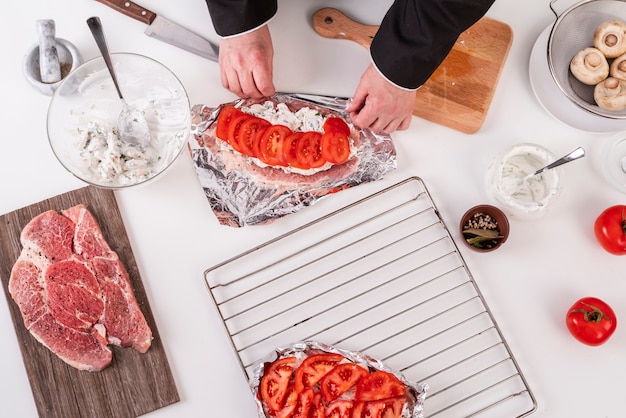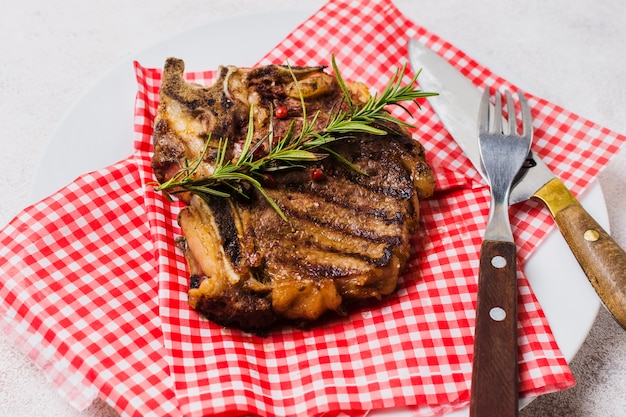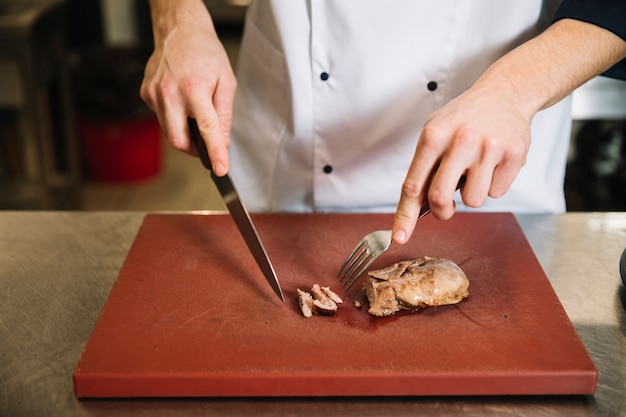Let me tell you, there's nothing quite like sinking your teeth into a perfectly cooked T-bone steak. The juicy, tender meat, the crisp sear, the delightful contrast between the lean sirloin and the flavourful, fat-marbled tenderloin – pure culinary bliss! Now, I've been grilling and pan-frying steaks for years, and over time, I've gathered a treasure trove of tips and tricks that have transformed my steak game. This guide is my love letter to the T-bone, a culmination of my experiences and a roadmap to achieving steak perfection. I'll walk you through everything from choosing the right cut to mastering the cooking technique and even crafting the perfect side dishes to complement your masterpiece.
Part 1: choosing the right steak

Finding Your Perfect T-Bone
The first step to a killer steak is choosing the right cut. I'm talking about a T-bone that sings with quality. You want a thick, well-marbled steak with a good amount of fat, which adds flavour and tenderness. Now, I'm a big fan of dry-aged beef, it adds an incredible depth of flavour and a slightly nutty aroma that's truly irresistible. If you're new to the game, go for a good quality, wet-aged T-bone – you won't be disappointed. Look for a steak that has a good amount of fat marbling, as this will ensure a juicy, flavorful steak. The fat will melt during cooking, adding richness and flavour to the meat.
Understanding Steak Grades
Don't be intimidated by the grades you see at the butcher's. In the UK, we use the 'Grading System' for beef. This system classifies beef based on age, breed, and fat content, giving us an idea of the quality and flavour we can expect. Let's break it down:
- Premium Beef: The highest grade, often offering the most marbling and tenderness. You'll find the most flavour in these cuts. Look for steaks with a "AAA" or "AA" grade for the most flavourful and tender cuts.
- Standard Beef: A good all-rounder with decent flavour and a balance of marbling and tenderness. These cuts will usually have a "A" or "R" grade.
- Select Beef: A more lean option with a slightly less flavourful profile. This grade will be marked with an "N" or "O".
While higher grades are certainly more expensive, they often offer a better overall eating experience. However, don't feel pressured to always buy the most expensive cut. You can still enjoy a delicious T-bone steak even if you choose a lower grade. The most important thing is to choose a steak that looks good and feels firm to the touch.
Don't Forget the Bone!
The bone is an essential part of the T-bone experience. It's not just for show! It acts as a heat conductor, helping to cook the steak more evenly. This is especially important when grilling, as the bone helps to distribute heat evenly and prevent the steak from overcooking. And let's be honest, there's something undeniably satisfying about digging into a juicy steak with a bone in hand. It adds a primal element to the experience, and it feels like a true celebration of the meat.
Part 2: Preparing for Perfection

Patting it Down and Leaving It Alone
Once you've got your T-bone home, give it a good pat dry with some kitchen paper. We want a dry surface for a beautiful sear. You see, a dry surface helps the steak develop a crisp, flavorful crust. Then, resist the urge to touch it! Leave it out of the fridge at room temperature for about 30 minutes. This allows the steak to warm up and cook more evenly. Think of it as a steak spa session before its big moment. It allows the steak to come up to room temperature, which is essential for even cooking. A cold steak will take longer to cook and might result in an uneven doneness.
Salt, Pepper, and More?
Now, the seasoning. It's a simple but crucial step. Salt is your best friend here, drawing out moisture and enhancing flavour. I like to season my steak generously with kosher salt and freshly ground black pepper about 30 minutes before cooking. You can add other herbs and spices, but keep it simple. I often add a pinch of garlic powder and paprika for a touch of warmth. Don't overdo it with the seasoning, as it can overwhelm the natural flavour of the steak.
The Importance of Resting
Before we dive into the cooking techniques, let's talk about the importance of resting. This is a crucial step that many people skip, but it's essential for a juicy, tender steak. After cooking, transfer your steak to a cutting board and let it rest for 5-10 minutes. During this time, the juices redistribute throughout the steak, resulting in a more tender and flavourful bite. Think of it as giving the steak a chance to recover from the heat and allow the juices to redistribute.
Part 3: Mastering the Cooking Technique

The Pan-Fried Powerhouse
For a crispy sear and a beautifully cooked interior, pan-frying is my go-to method. Get a cast iron pan screaming hot, and I mean screaming! Add a tablespoon of oil – I prefer grapeseed oil for its high smoke point. Now, carefully place your steak in the pan and resist the urge to move it for the first couple of minutes. We want that beautiful crust to form. This step is crucial for developing a beautiful crust on the steak. A hot pan will sear the steak quickly, locking in the juices and creating a delicious crust.
Flipping It Right
You'll know it's time to flip when the steak has developed a beautiful, dark brown crust. Don't be afraid to use tongs to flip it, but be careful not to pierce the steak. This will help to prevent the juices from escaping. After flipping, cook the second side for the same amount of time as the first.
The Secret Weapon: Resting
After you've cooked both sides of the steak, it's time to rest it again. This will allow the juices to redistribute, ensuring a tender and juicy steak. Transfer your steak to a cutting board and cover it loosely with foil. Let it rest for 5-10 minutes before slicing and serving.
Part 4: Perfecting Your steak doneness
Know Your Steak
Choosing the right doneness is a matter of personal preference. But here's the lowdown on how to achieve each level:
| Doneness | internal temperature | Description |
|---|---|---|
| Rare | 125-130°F (52-54°C) | Cool red centre |
| Medium-Rare | 130-135°F (54-57°C) | Warm red centre |
| Medium | 135-140°F (57-60°C) | Pink centre |
| Medium-Well | 140-145°F (60-63°C) | Very little pink |
| Well-Done | 145-150°F (63-66°C) | Completely brown |
A rare steak will be very red in the centre, while a well-done steak will be completely brown. Ultimately, the choice is yours!
Using a Thermometer
For consistent results, it's best to use a meat thermometer. Insert it into the thickest part of the steak, making sure it doesn't touch the bone. If you're unsure about the doneness, check the internal temperature and use the table above as a guide. Don't rely on the colour of the meat alone to determine doneness, as this can be misleading.
Part 5: Adding That Finishing Touch
A Little Butter Magic
While the steak is resting, melt a knob of butter in the pan. Add a few sprigs of fresh thyme and rosemary for extra flavour. Then, baste the steak with the infused butter, allowing it to absorb the aromatic flavours. This adds an extra layer of flavour and richness to the steak.
The Sauce Factor
If you're feeling fancy, you can create a simple pan sauce by deglazing the pan with a splash of red wine or beef broth. Scrape up the delicious brown bits from the bottom of the pan, allowing the sauce to reduce and thicken. It's a quick and easy way to add depth and richness to your steak. This creates a sauce that is full of flavour and adds a touch of elegance to your steak.
Part 6: The Sides That Shine
No T-bone steak is complete without some stellar sides. Think creamy mashed potatoes, roasted vegetables, or a classic green salad. I love the contrast of textures and flavours, so I usually opt for a mix of options. Here are a few side dish ideas that pair perfectly with a T-bone steak:
- Roasted Vegetables: Try roasted asparagus, Brussels sprouts, or carrots for a flavourful and healthy side dish.
- Mashed Potatoes: A classic comfort food that pairs perfectly with a juicy steak.
- Green Salad: A light and refreshing side dish to cut through the richness of the steak.
- Garlic Bread: A warm and comforting side dish that complements the flavour of the steak.
- Creamed Spinach: A rich and creamy side dish that adds another dimension of flavour to your meal.
Don't forget a generous dollop of your favourite sauce, whether it's a classic béarnaise or a spicy chimichurri.
Part 7: A Toast to Your Success
There's nothing quite like that moment when you slice into a perfectly cooked T-bone steak. The juices running clear, the beautiful pink centre, and that irresistible aroma – it's a moment of pure culinary satisfaction. Pair your masterpiece with a glass of full-bodied red wine, and raise a toast to your hard work.
Part 8: FAQs
1. What's the best way to store a T-bone steak?
To ensure freshness, store your T-bone steak in the refrigerator, wrapped tightly in plastic wrap or butcher paper. You can also freeze it for up to 3 months. Remember to thaw it slowly in the fridge before cooking. Freezing can affect the texture of the steak, so it's best to thaw it slowly in the refrigerator to ensure that the juices are retained.
2. How long should I cook a T-bone steak for?
cooking time varies depending on the thickness of your steak and your desired doneness. A general rule of thumb is 4-5 minutes per side for medium-rare. However, it's best to use a meat thermometer for precise results. You can also use a visual guide to determine doneness. Look for a steak that is firm to the touch and has a beautiful crust on the outside.
3. Can I cook a T-bone steak in the oven?
Absolutely! For a more even cook, you can roast your T-bone in the oven at 375°F (190°C) for about 10-12 minutes per side for medium-rare. However, you'll miss out on the beautiful pan-fried crust. This method is best for larger steaks, as it allows the heat to penetrate the steak more evenly.
4. What if my steak is overcooked?
Don't panic! It happens to the best of us. Even if you've overcooked your steak, there are still ways to salvage it. Try slicing it thinly, adding a flavorful sauce, or serving it over a bed of creamy polenta to soften the texture. Overcooked steak can still be delicious, it's just a little less tender.
5. What's the best way to tell if a T-bone steak is cooked to the desired doneness?
The most reliable way is to use a meat thermometer. However, you can also use the "finger test". If your steak feels firm and springy to the touch, it's medium-rare. If it feels firmer and more resistant, it's closer to medium-well. But remember, this method is less precise and more suited to experienced steak connoisseurs.
I hope this guide has given you all the confidence you need to cook a perfect T-bone steak. Remember, the key is to practice, experiment, and enjoy the process! So grab your T-bone, fire up the pan, and get ready for a culinary adventure!
Everyone is watching

Prime Rib Roast Cooking Time Chart: Per Pound Guide
Cooking TipsPrime rib roast. Just the name conjures images of lavish dinners, crackling fires, and hearty laughter. It’s ...

How Long to Bake Potatoes in the Oven (Perfect Every Time)
Cooking TipsBaked potatoes are a staple in my kitchen. They're incredibly versatile, delicious, and surprisingly easy to m...

Perfect Rice Every Time: The Ultimate Guide to Cooking Rice
Cooking TipsAs a self-proclaimed foodie, I've always been a bit obsessed with rice. It's the foundation of countless cuisi...

The Ultimate Guide to Cooking Asparagus: Tips, Techniques, and Recipes
Cooking TipsAsparagus. The mere mention of this spring delicacy conjures up images of vibrant green spears, crisp and burs...

Ultimate Guide to Cooking the Perfect Thanksgiving Turkey
Cooking TipsThanksgiving. Just the word conjures up images of overflowing tables laden with delicious food, the scent of r...
